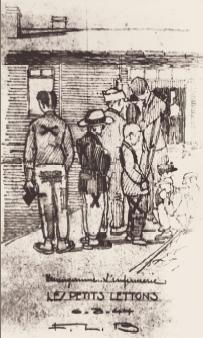Prisoners from the Soviet Union and the Baltic Countries
Prisoners from the Soviet Union
Between 1942 and 1944, around 2.8 million people from the parts of the Soviet Union occupied by the Germans were systematically deported to Germany for slave labor. More than half of them were women. POWs from the Red Army added to the number of deported Soviet citizens. These so-called “eastern workers” were subjected to terrible working and living conditions in work camps and factories. The majority of these Soviet prisoners were taken to concentration camps for disobeying the strict work regulations or for attempting to escape. The 22,000 Russian and Ukrainian prisoners (around 2,000 of them women) formed the largest group of prisoners in Neuengamme. The treatment they received was especially brutal and the mortality rate among them was especially high because they were classified as “racially inferior”. Due to the strong need for qualified workers in the German armaments industry, some of the Soviet prisoners eventually managed to be transferred to more bearable work places.
Soviet POWs in the “POW Work Camp”
The German Wehrmacht attacked the Soviet Union on 22 June 1941. By the end of the same year, the Wehrmacht had captured around three million Soviet soldiers.In the POW camps, Jewish soldiers and Communist Party officials were singled out and murdered. During the winter of 1941/42, around two million Soviet POWs died of hunger, cold, disease and the inhuman treatment they were subjected to.In October 1941, the Wehrmacht handed over 10,000 Soviet POWs to the SS, 1,000 of whom were later transferred toNeuengamme from Wietzendorf concentration camp. At Neuengamme, they were crammed into a detached section of the camp known as the “POW work camp”. Within the space of eight months, 652 of these Soviet POWs had died. The survivors were transferred to Sachsenhausen concentration camp in June 1942. Their fate is unknown.
Prisoners from the Baltic Countries
After the Wehrmacht occupied the Baltic States in the summer of 1941, the Germans established the “Reichskommissariat Ostland” which consisted of Estonia, Latvia, Lithuania and Belarus. In the same year, the majority of the area’s Jewish inhabitants were murdered by SS squads. The survivors were deported to ghettos and slavelabor camps. The Security Police (Sicherheitspolizei) set up “labor and education camps” for political opponents and members of other persecuted groups. Around 3,800 people from the Baltic states were imprisoned in Neuengamme, about 3,300 of them from Latvia. Most of them arrived there on three transports between July and October 1944 from the Salaspils “labor and education camp” near Riga. According to current estimates, several hundred of these prisoners were women,some of them Jewish. A large number of these women were transferred to the Hamburg-Langenhorn and Hannover-Langenhagen satellite camps via Stutthof concentration camp.
